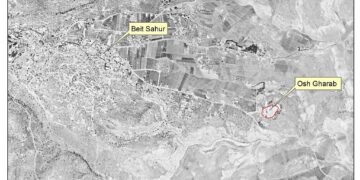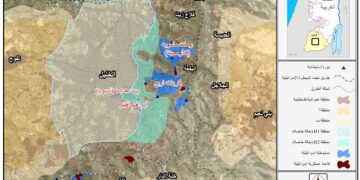- Violation: establishing colonial outpost
- Location: Fuqeiqis- Dura town
- Date: February 2018
- Perpetrators: Negohot colonists
- Victims: residents of the area
Details:
Some colonists from Negohot, which is established on confiscated lands from West Dura town, established new outpost to the west of the colony.Reportedly, construction work started in February, a road was opened to link the recently confiscated lands to the colony. Electricity and other services were provided to the area , where colonists erected some tents and barns to initiate life in there.It is worth mentioning that the attacking colonists are herders and that they started grazing their sheep in new outpost.
Photos 1+2: the new outpost
It is also reported that one of the colonist herders tends to chase and assault Palestinian herders in the area and ban them access to their lands.
Colonial interests in the area became clear couple of years ago. It is when colonists took over lands to the west of Fuqeiqis village. The confiscated lands were atop of a mountain that overlooks Beit Awwa and other villages and were planted with olives and grapes by colonists upon the takeover.
Photo 3: side of the planted lands
Noteworthy, two Israeli colonies Negohot and Mirshalem are located nearby the confiscated mountain top. Palestinian residents of the area fear to witness colonial expansion on their lands as a result.
The colony's guards hold regular tours in the neighboring Palestinian lands and check farmers while working there.
It should also be marked that Negohot colony is undergoing rapid and quick expansion in the western and northern parts.
Photo 4: some of the expansion works in Negohot
About Fuqeiqis:
Located to the west of Dura town in Hebron governorate, the village populates 1000 people, most of whom are employed.
It should be marked that Negohot colony is located on confiscated lands from the village. Colonists residences are few meters away from the houses of villagers. Thus, the area witness many colonists' attacks and violations every now and then.
Land Research Center sees Israel continuous expansion on colonies in the West Bank and Jerusalem at the expense of Palestinian and lands a flagrant violation of Human Rights and all international laws and conventions, which prohibit disposition of public properties in occupied countries.
UN Resolutions
UN Security Council Resolution 242 of 1967: calls for
- the Withdrawal of Israel armed forces from territories occupied in the recent conflict;
- Termination of all claims or states of belligerency and respect for and acknowledgment of the sovereignty, territorial integrity and political independence of every State in the area and their right to live in peace within secure and recognized boundaries free from threats or acts of force." [4]
UN Security Council Resolution 449 of 1979: the Security Council determined:
- "that the policy and practices of Israel in establishing settlements in the Palestinian and other Arab territories occupied since 1967 have no legal validity and constitute a serious obstruction to achieving a comprehensive, just and lasting peace in the Middle East"
UN Security Council Resolution 452 of 1979: states that
- "the policy of Israel in establishing settlements in the occupied Arab territories has no legal validity and constitutes a violation of the Fourth Geneva Convention relative to the Protection of Civilian Persons in Time of War of 12 August 1949" and "calls upon the Government and people of Israel to cease, on an urgent basis, the establishment, construction and planning of settlements in the Arab territories occupied since 1967, including Jerusalem."
UN Security Council Resolution 465 of 1980:
- It expressed concern at Israeli settlement policy in the Arab territories and recalled resolutions 237 (1967), 252 (1968), 267 (1969), 271(1969) and 298 (1971). It further called upon the State and people of Israel to dismantle such settlements. The resolution calls on all states ‘not to provide Israel with any assistance to be used specifically in connection with settlements in the occupied territories’.
Prepared by
The Land Research Center
LRC
















